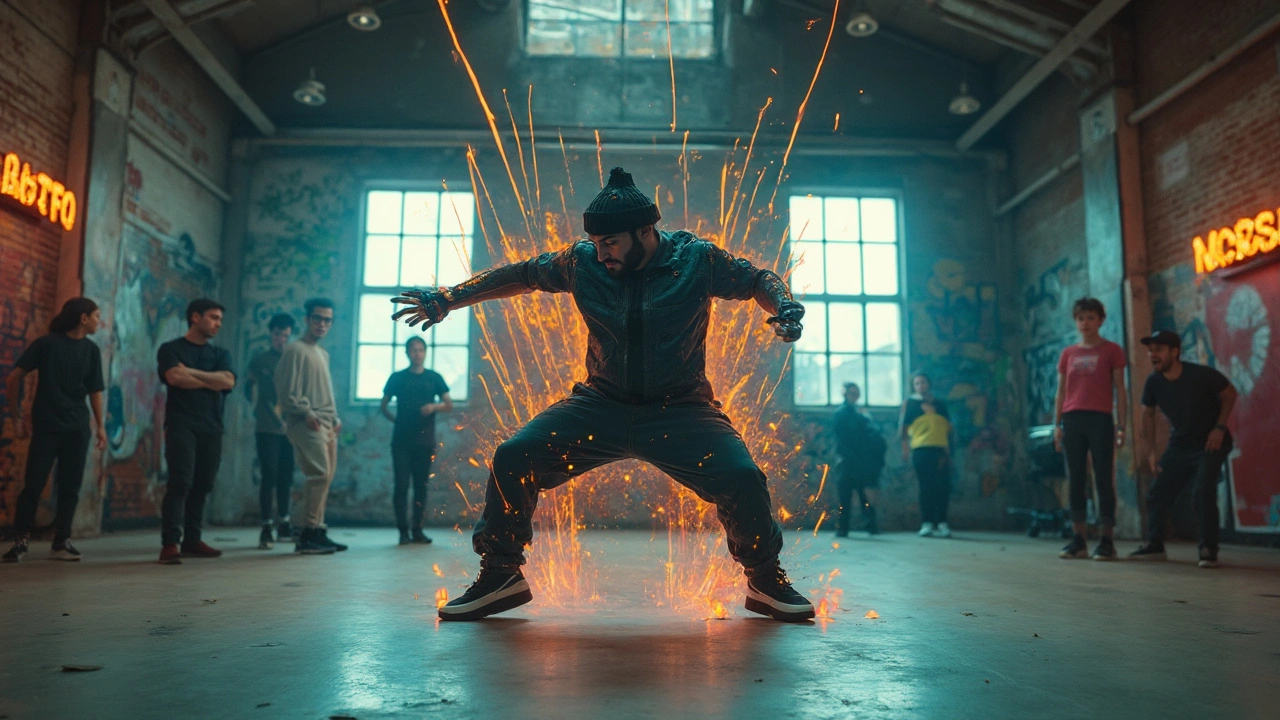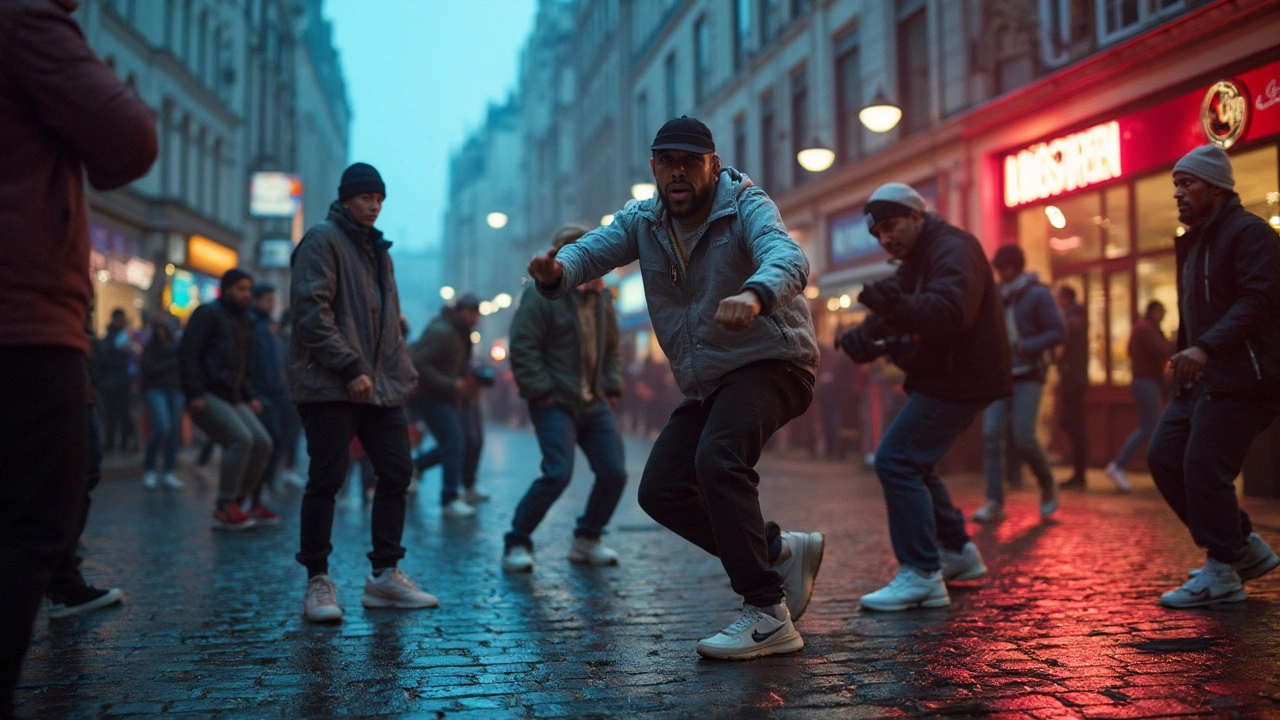Ever seen someone bust out impossibly smooth, jerky moves that match every crazy wobble and bass drop in a dubstep track? That’s dubstep dance. It exploded when people realized you could literally 'see' the music in the way dancers moved—every sound has its own step, snap, or pop.
What’s cool about dubstep dance is you don’t need loads of training or a fancy costume. If you can feel the music and aren’t afraid to look a little weird, you already have a head start. People from all kinds of dance backgrounds jumped in: some came from popping, others from hip hop, and plenty just learned at home by copying YouTube videos.
The best part? There are no hard rules. You can mix isolation techniques (think: one part of your body moving while the rest stays frozen) with big gestures and slow-mo slides that sync perfectly with the glitchy parts of a dubstep track. Doubtful? Try standing in front of a mirror and moving your arms super slow next time Skrillex drops a beat—suddenly, you’re freestyling like a pro.
- How Dubstep Created a New Dance Scene
- Signature Moves and Styles
- Learning Dubstep Dance: Tips and Tricks
- Where to Find Dubstep Dance Battles and Events
How Dubstep Created a New Dance Scene
Back in the mid-2000s, dubstep music started shaking up underground clubs in London. Fast-forward a few years, and YouTube became flooded with crazy videos of kids dancing to those spaced-out, bass-heavy tracks. This wasn’t just another version of breakdancing or popping. Something fresh was happening. People all over the world realized dubstep had the right kind of sound—a wild mix of fast rhythms, deep bass, and weird electronic noises—that made bodies want to move in a totally new way.
Dancers started breaking away from classic hip hop or street dance rules. They took bits of popping, tutting, and animation, mashed them together, and timed every little motion to those sharp sounds that dubstep throws at you. If you watch videos by dancers like Marquese “Nonstop” Scott, you’ll see what I mean. When his 2011 YouTube video went viral, it didn’t just rack up millions of views; it basically put dubstep dance on the map for everyone, everywhere.
Here’s why dubstep dance clicked:
- The music itself is unpredictable, with random stops, drops, and distortions.
- No complicated choreography needed—freestyle is totally welcome.
- Social media made it easy for anyone with a phone and a speaker to share moves and get noticed.
Check out this quick timeline of how fast dubstep dance spread:
| Year | Key Event |
|---|---|
| 2005 | Dubstep clubs pop up in London |
| 2009 | Skrillex and other producers make dubstep tracks go global |
| 2011 | Nonstop’s “Pumped Up Kicks Dubstep” dance video becomes a viral hit |
| 2013 | Dubstep dance competitions start in the US and Europe |
Another thing: dubstep dance isn’t just about looking cool. For a lot of people, it became a way to stand out from the crowd when everyone else was doing the same old moves. Suddenly, you had crews inventing new styles, collaborating across continents, and building a whole community online. Anyone could upload a routine or a freestyle, get feedback, and maybe even go viral themselves.
Signature Moves and Styles
If you watch a dubstep dancer, you’ll spot moves that look like someone hit the slow-mo button then switched to fast forward—sometimes all within a few seconds. This dance style is famous for sharp contrasts: big, snappy hits blend with super controlled isolations. Here’s what’s really going on under the hood.
- Popping and Locking: These moves are all about sharp muscle contractions that match the beats. The chest pop, arm wave, and leg lock are go-tos because dubstep tracks have lots of sudden stops and drops.
- Animation: Think robot but less cheesy, more smooth. Animation relies on making your body move as if you’re a character in a stop-motion film, syncing perfectly with glitch sounds or synth sweeps.
- Gliding and Sliding: Dancers use footwork tricks that create the illusion of floating or sliding across the floor (yes, the famous moonwalk counts). Gliding fits right in whenever the music stretches or swells.
- Tutting: This is all about creating boxy, geometric shapes with your arms and hands. Tutting works well during fast, choppy sections of the song.
- Waves and Liquid: Full-body waves and wrist rolls flow with slower, rolling bass notes or melodic parts.
Surprisingly, a lot of these moves came from earlier street dance styles, but got fine-tuned to fit dubstep’s wild sound. Some of the most-viewed dubstep dance clips on YouTube—like Marquese “Nonstop” Scott’s remix of Pumped Up Kicks—racked up over 140 million views, proving how addictive and eye-popping these styles really are.
| Move | Best For | Origin |
|---|---|---|
| Chest Pop | Bass drops | Popping |
| Glide/Moonwalk | Synth sweeps | Street dance |
| Tutting | Choppy beats | Hip hop |
| Robot | Mechanical sounds | Animation |
| Isolation | Breaks in music | Popping/Locking |
It doesn’t matter if you start on carpet or a smooth kitchen floor—practice these moves while listening to different dubstep tracks and tweak them to match your own style. Nobody gets it perfect the first time, but that’s half the fun. The real secret is about listening closely to the song and letting your body “paint” each sound so that even someone watching on mute knows when that drop is about to hit.

Learning Dubstep Dance: Tips and Tricks
Diving into dubstep dance can look intimidating, but trust me, anyone can start. You don’t need expensive lessons or a huge open studio—just a bit of space, some music, and your phone to record and check your moves. Most people pick up the basics by watching tutorials or following their favorite dancers on social media.
Want to learn fast? Break the style down into these simple steps:
- Listen closely to dubstep tracks. Get familiar with drops, glitches, and the way the beat changes. Your dance should match the music, like you’re translating sounds into moves.
- Start with popping and waving. These two moves are the bread and butter of dubstep dance. Popping is about quick, sharp muscle movements, while waving is all about making your arms and body look like they’re melting.
- Work on isolations. Isolations mean moving one part of your body at a time—think robot arms or sliding just your shoulders while everything else stays still.
- Use slow motion and speed switches. Dubstep music is famous for sudden tempo changes, so practice going from super slow to super fast.
- Film yourself. Watching your own videos helps you spot things that feel weird and shows you where your timing is off.
Dancers often wonder how long it’ll take to get good. Honestly? Most beginners see real progress in a couple of months with regular practice (about three times a week). Here’s a quick comparison of learning curves for common moves:
| Move | Avg. Time to Learn (1 hr sessions) | Difficulty |
|---|---|---|
| Popping | 2-3 weeks | Easy/Medium |
| Waving | 1-2 weeks | Easy |
| Isolations | 4-5 weeks | Medium/Hard |
| Speed Switches | 2-3 weeks | Medium |
A useful trick: watch and try tutorials from real dubstep dancers, not just regular street dancers. For example, Marquese Scott’s YouTube channel is a goldmine for fresh ideas. Practice with a mirror and don’t sweat it if you mess up at first—nobody nails it on day one. Stick with it, and you’ll find your groove. Oh, and if a move feels too tough, break it into smaller chunks. Piece it together slowly, then add music once you’re comfy with the basics.
The most important thing? Let yourself have fun. Don’t get stuck comparing yourself to viral dance clips—most of them are edited or rehearsed. *Dubstep* dance is all about self-expression, so go ahead and show off your weirdest moves on the drop.
Where to Find Dubstep Dance Battles and Events
If you’re itching to show off your moves or just want to catch the best dubstep dance throwdowns, you have a ton of options, both in-person and online. Not every city runs epic dubstep battles every week, but knowing where to look makes everything easier.
The most famous events where dubstep dancers throw down include World of Dance, Red Bull Dance Your Style, and the annual Juste Debout in Paris. In the US, World of Dance throws regional qualifiers for their huge championship, where dubstep dancers steal the spotlight with bass-heavy solos. LA and New York both have regular club nights and local street battles—just check their community calendars or Facebook groups for "dubstep dance battle" listings.
If traveling’s not in the cards, you’ll find plenty popping up on streaming platforms. YouTube channels like Fik-Shun, Marquese Scott (aka Nonstop), and TURFinc post battles and solo videos that rack up millions of views. Twitch and TikTok are now getting loaded with weekly or monthly live streams of freestyle dubstep sessions. Here’s a tip: try searching hashtags like #dubstepdance or #dubstepbattle—there’s something new almost every week.
If you want to jump in yourself, here’s a quick checklist:
- Follow local dance studios on Instagram—they often announce pop-up battles.
- Check Eventbrite for upcoming urban dance events and regional qualifiers.
- Join Discord and Facebook groups for dubstep dance enthusiasts to hear about meetups.
- Submit a video to online competitions—many take remote entries now, especially since 2020.
Curious about how popular these events are? Here’s a quick look:
| Event Name | Location | Annual Attendance |
|---|---|---|
| World of Dance Finals | Los Angeles, US | ~12,000 |
| Juste Debout | Paris, France | ~15,000 |
| Red Bull Dance Your Style | Global (Rotates) | ~10,000 |
So, whether you want to vibe from your couch or dance in front of screaming crowds, there’s a place to plug into the world of dubstep dance battles and events.

